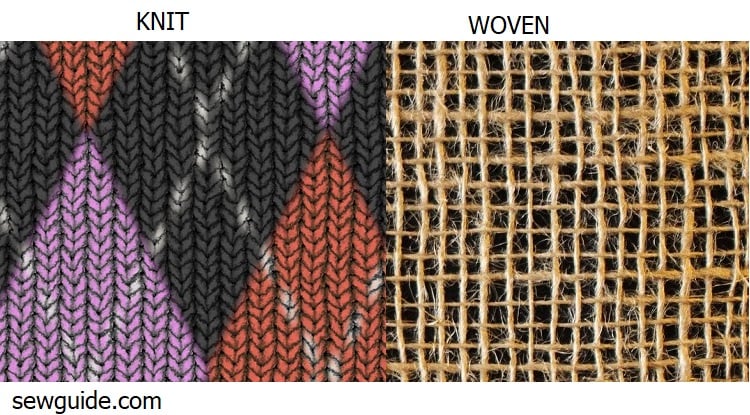Fabrics can be made by many methods but the most important ones are weaving and knitting and these processes in turn create the most important types of fabrics – wovens and knits. Comparing them are like comparing apples and oranges; but here we are and let us do it.
Knits and woven fabrics have their own admirers. Asking them to choose between the two will be easy – they have already zeroed in on their prefered features.
Some sewists swear by their favourite knits – silk knits, ponte roma, interlocks…They prefer knits because of their softness and comfortable wear.
Others prefer wovens for their elegance and beauty. And structure. And strength.
Knits and woven have their specialties and differences that make them unique. It is easy to distinguish between the two if you know what to look for
Differences between Woven and knitted fabrics
Manufacturing process
Knits are fabrics made by knitting – both hand knitting and with specialized knitting machines. Knit fabric is made by interloping one continuous yarn or multiple yarns, with lengthwise as well as crosswise interlocking looped stitches.
Woven fabrics are made by weaving – both hand weaving and with specialized weaving machines. Woven fabric is made of a series of lengthwise yarns interlaced with crosswise yarns in a number of weaving patterns.

Structure of knits and wovens are different
Knits have a vertical column of stitches forming lengthwise ribs called wales and crosswise lines called courses, which are basically vertically and horizontally interconnected stitches. On most knits, the wales can be seen on the right side of the fabric and the courses can be seen on the wrong side of the fabric.
Woven fabric is made of lengthwise yarns (warps) interlaced with crosswise yarns (wefts) with a distinct pattern.
Knit fabrics stretch more than woven fabrics.
Knit fabrics stretch along the length and width but more along the width than the length. The structure of the fabric allows it to stretch and recover the original shape and form – this makes the knit fabrics more suitable for body hugging figure shaping clothes.
Woven fabrics do not stretch much but can stretch more along the diagonal and a little along the length than the width. Woven fabrics can stretch when cut on the bias or when spandex is added for stretch. Woven fabric will need extra fabric to add extra ease to a garment.
You wouldn’t think of making a tightfitting garment without any fasteners with a woven fabric, would you?
Because of the stretch, when you sew with knits you may not need to bother about fasteners like zippers, buttons etc. As the garment will stretch, you can put on knit garments without the help of any fastener. But for wovens you will need to add buttonstands, buttonholes, zipper insertions, plackets, slits, vents etc.
Knits do not wrinkle as much as woven.
There are many kinds of knits, some thin, some thick. But try scrunching any of them up in your hands and then release; you will find that the fabric will bounce back to its original looks.
But not so with woven fabrics. A woven fabric will retain all the wrinkles.
Differences in edges
The woven fabric has a special edge called selvage at the left and rightside along the lengthwise grain. It prevents the fabric from unraveling.

But cut edges of the woven fabric usually unravels. You will have to use some finishing techniques to prevent the fraying of threads. Usually a serged finish is made along the woven fabric edges. Other seam techniques like french seams, flat felled seams are used to hide the frayable woven fabric edges.
Cut edges of knit fabrics do not ravel. This is an advantage in sewing because you do not necessarily have to finish the seam edges.
There is a problem with thin knits – they curl along the edges. Cotton jersey fabric which is one of the most popular knit fabrics roll to the front if you stretch it.
Hand and feel of Knits and Wovens as dressmaking fabrics
Knits are generally very soft, and comfortable to wear. They are very flattering as dressmaking fabrics because of flexibility and good drape. For eg. silk knits, tshirt knits.
Woven fabrics are generally not as soft as knits. There are very very soft woven fabrics, for eg. rayons, silks. But there are equally rough and stiff fabrics.
When you want to make a garment with structure you naturally think of heavy weight fabrics like twill weave fabrics. They can be downright stiff like canvas to somewhat crisp like organdy
But wovens can make very see through fabrics like organdy. Knits are more heavier that way.
Knits shrink more than wovens
Knit sweaters getting considerably small after a first wash is a regular complaint.
This is because knit fabrics are made up of interlocking loops of yarn, and when these loops are heated, they contract. Woven fabrics also shrink but some knits shrink a lot more.
As any one who has used these fabrics (which is everybody) will know that both are beyond awesome. It is just that there are qualities that you may value more on some than on others. The type of fiber used (For eg, polyester, cotton etc) is another very important criterion in selecting fabric to buy, as much is choosing between knits and wovens.
Related posts : What are textiles
